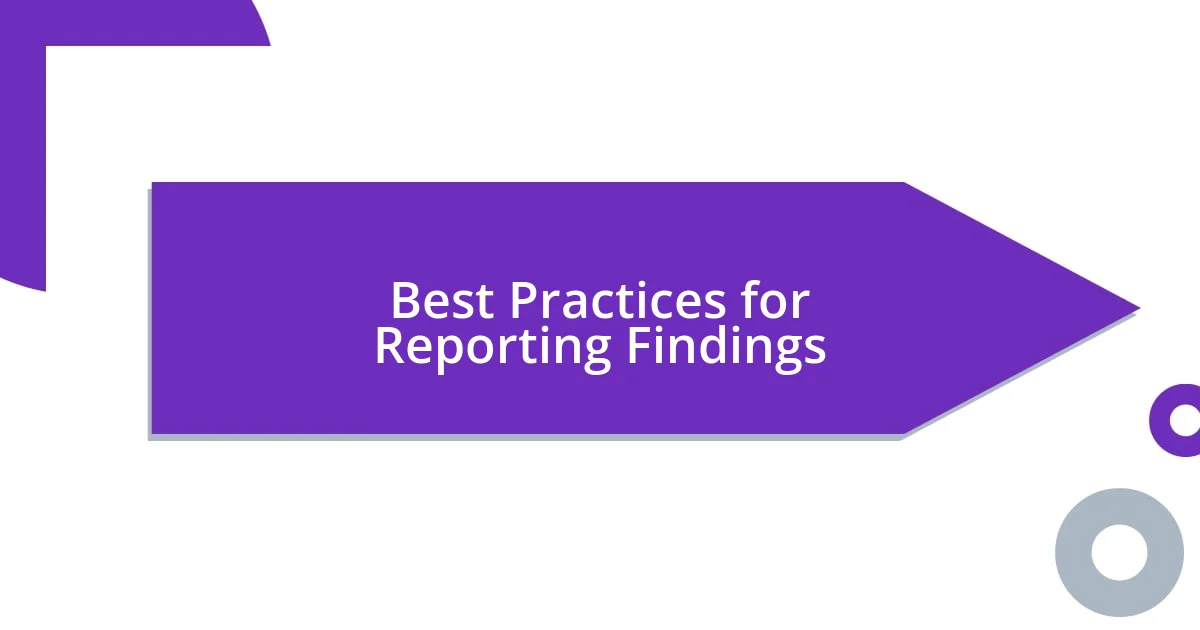Key takeaways:
- Effective accident investigations start with securing the scene and collecting preliminary information to preserve valuable evidence.
- Thorough evidence collection and analysis, including witness interviews and forensic techniques, are crucial for uncovering the truth and informing safety improvements.
- Clear reporting of findings, prioritizing significant results, and utilizing visual aids enhances communication and engagement with stakeholders.

Understanding Accident Investigation Process
Accident investigations often begin with the immediate response to the incident, where gathering preliminary information is crucial. I remember one particular case where first responders quickly secured the scene, and that decisive action ensured valuable evidence wasn’t compromised. Isn’t it fascinating how the first moments can set the tone for the entire investigation?
As the investigation progresses, detailed interviews with witnesses and involved parties become pivotal. I recall interviewing a witness who was visibly shaken and struggled to recall details. Their emotional state highlighted how trauma could cloud memory, raising the question: How reliable are eyewitness accounts, really? Each person’s perspective can shape the findings in ways we sometimes underestimate.
Finally, the analysis phase involves meticulously examining the evidence collected to establish what went wrong. In one investigation I worked on, the revelation of a small mechanical fault led to a much larger understanding of systemic failures. It made me wonder how many accidents could be prevented if we looked beyond the obvious. Each layer of insight can lead to significant changes in safety protocols that ultimately save lives.

Steps in Conducting Accident Investigations
Accident investigations follow a series of defined steps that, if adhered to, can lead to enlightening outcomes. Initially, the scene must be preserved and documented thoroughly. I remember a time when I arrived at a site shortly after an accident, and the chaos was palpable. Establishing order and capturing details through photographs was essential; every element played a role in piecing together the sequence of events.
Next, gathering evidence involves collecting physical items, sketches, and any available data about the incident, much like putting together a puzzle. I recall a case where an overlooked safety log revealed a pattern of negligence that was shocking to everyone involved. This moment solidified my belief that the details matter greatly; sometimes, the smallest piece of evidence can unveil a larger narrative of safety oversight.
The final stage often culminates in developing recommendations and implementing changes to prevent future occurrences. I felt a sense of fulfillment when our team’s findings led to the introduction of new safety measures. Reflecting on that experience, it became clear how each step of the investigation is not just about understanding the past but also about shaping a safer future for everyone involved.
| Step | Description |
|---|---|
| Initial Response | Preserve the scene and gather preliminary information. |
| Evidence Collection | Collect physical evidence, witness statements, and documentation. |
| Analysis and Recommendations | Analyze findings and suggest preventive measures. |

Importance of Evidence Collection
Evidence collection is the backbone of any accident investigation. I’ve seen firsthand how critical the right evidence can be in either exonerating individuals or shining a light on negligence. I once participated in a case where a witness turned over their mobile phone, revealing video footage that chronicled the moments leading up to the accident. This simple act transformed our understanding of the event, emphasizing that even the smallest piece of evidence can hold immense power.
Here’s why evidence collection is indispensable:
- Establishing Facts: Evidence helps replace speculation with facts, giving a clear account of what happened.
- Supporting or Disproving Claims: Collected evidence can substantiate testimonies or challenge false narratives.
- Identifying Patterns: Evidence across multiple cases can reveal trends, leading to broader safety improvements.
Every piece we gather isn’t just a fragment; it’s part of a larger story. In another instance, I witnessed how a seemingly mundane maintenance record pointed to negligence that had been overlooked for years, ultimately altering attitudes toward safety protocols within that organization. It’s moments like these that fortify my belief in thorough evidence collection—because behind every detail lies the potential to save lives and reshape practices.

Techniques for Analyzing Evidence
Analyzing evidence in accident investigations requires a systematic approach, and one effective technique is the use of forensic analysis. I remember a specific incident where we employed this method to examine tire marks at the scene. Through careful scrutiny, we determined the vehicle’s speed at impact. The realization hit me hard; how much could have been different if that driver had just applied the brakes a second earlier? This detailed analysis not only provided clarity but also deepened my appreciation for meticulous evidence examination.
Another powerful technique is the use of technology, such as drone imagery and 3D modeling. I was part of a project where drone footage captured an aerial view of an accident scene that was difficult to assess from ground level. Experiencing that moment brought a new dimension to our understanding, as the overhead perspective revealed sightlines and obstructions that weren’t immediately apparent. It makes you wonder—are we leveraging all the tools at our disposal to understand the full story?
Interviews with witnesses also play a crucial role. Just last year, I found myself interviewing a bystander who had seen the entire accident unfold. The emotions in their voice and the details they provided changed the direction of our investigation entirely. It’s a stark reminder that human experiences often bring invaluable insights. What if we overlook those voices? Each conversation can unlock new understandings and enhance the narrative we are trying to piece together.

Common Challenges in Investigations
Navigating the complexities of accident investigations often presents unique challenges that can stymie progress. One obstacle I frequently encountered was the reliability of witness accounts. During one incident, I was relying heavily on two witnesses who provided conflicting statements. It left me feeling frustrated and puzzled—could we trust either of them? This experience underscored the importance of corroborating witness statements with tangible evidence to paint a clearer picture of the events.
Another common challenge is the emotional toll these investigations can take on everyone involved. I remember a case where family members of the victim were visibly distraught during the investigation. Their grief added layers of difficulty, making it hard to maintain objectivity. In times like these, I learned the importance of conducting investigations with empathy, ensuring that we respect the emotional landscape while still pursuing the truth.
Moreover, resource limitations can often impede the investigative process. I once faced a situation where we lacked sufficient funding for comprehensive analysis tools. It was disheartening to realize that crucial data might slip through our fingers simply due to budget constraints. It makes you wonder—how many vital insights are lost because of inadequate resources? This experience pushed me to advocate for better funding and support, knowing that proper resources can often lead to breakthroughs in understanding the complexities of an accident.

Best Practices for Reporting Findings
When it comes to reporting findings from accident investigations, clarity is paramount. I recall a moment when we compiled our findings into a report that ultimately confused our stakeholders. Language that was too technical and dense could have been a barrier to understanding. I’ve learned that using straightforward language and bullet points not only ensures the information is accessible but also resonates more deeply with the audience. What good is a well-researched report if it doesn’t communicate its messages effectively?
Another best practice is to prioritize the most significant findings. I once prepared a lengthy document that covered every detail of an investigation. However, upon presentation, I noticed that the key points got lost in the minutiae. By isolating the most critical conclusions and discussing them first, I was able to capture attention and drive the conversation more effectively. This taught me the importance of crafting narratives around main findings to foster engagement. Are we making our critical insights too easy to overlook?
Finally, visual aids can significantly enhance reports. During one investigation, I created visual diagrams that illustrated the sequence of events. Incorporating these visuals not only helped clarify complex information but also provided a compelling narrative that held my audience’s interest. It’s fascinating how a simple diagram could trigger a deeper understanding. How often do we think about engaging our audience’s visual senses in our communications?

Lessons Learned from Real Cases
Reflecting on past investigations, I’ve learned that the importance of timing can’t be overstated. There was a case where we rushed to collect evidence, only to realize later that waiting a few hours would have allowed the scene to be preserved with more accuracy. This experience taught me that patience can be just as critical as the investigative process. How many times do we overlook the power of timing in our pursuit of truth?
Collaboration has also proven to be vital in accident investigations. I recall a particular incident where I partnered with engineers to analyze the structural failure of a bridge. Their expertise provided insights I never would have considered, and together, we uncovered factors that were key to understanding the accident’s cause. This taught me that no one person has all the answers. It begs the question—how often do we reach out for help when we think we can do it all ourselves?
Lastly, I’ve learned that the follow-up is just as crucial as the investigation itself. After solving a significant case, I reached out to the families involved to update them on the findings. I was met with such gratitude that it reinforced my belief in the human aspect of these investigations. It’s a reminder that these situations are not just about uncovering facts; they are deeply intertwined with real people and their lives. Are we doing enough to address the emotional aftermath of our findings?














